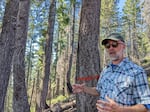Major legal win for environmental groups in Southern Oregon will protect old-growth forest
April 2, 2025
Environmental groups in Southern Oregon got a win in court this week in a lawsuit over old-growth forests.
A number of conservation groups sued the federal Bureau of Land Management two years ago over a new vegetation management plan covering southwest Oregon, called the Integrated Vegetation Management Plan. They argued the plan illegally authorized the logging of old-growth forests.

In a ruling Tuesday, U.S. District Court Judge Ann Aiken in Medford agreed with a previous ruling from a year ago that BLM had failed to adhere to its own resource management plan.
In that previous ruling, U.S. Magistrate Judge Mark D. Clarke found that the BLM’s use of commercial logging in late-successional reserves, forests dedicated to preserving animals like the northern spotted owl, violates the agency’s 20-year standard which limits activity in those forests to actions that do not delay habitat development for the northern spotted owl by 20 years or more. For example, the rule would prohibit a forest canopy to be removed if it would take over 20 years to recover for use as habitat for the northern spotted owl.
That decision halted the controversial Late Mungers timber sale in the Applegate Valley which included 830 acres of commercial thinning within late-successional reserves.
George Sexton, conservation director for KS Wild —one of the groups that filed the lawsuit — said they’ve been trying to get the BLM to focus less on producing as much timber as possible.
“If they could lean into forest resiliency and collaboration, they would still be logging; It’s just that logging wouldn’t be the sole driver of everything they do,” Sexton said.
The Medford BLM did not respond to requests for comment.
The agency can still appeal the ruling if they want to. Otherwise, Sexton said the two sides will get together to figure out how the government can be in compliance with the judge’s ruling.
“You can do small-diameter fuels treatments,” Sexton said. ”You can do restoration thinning, but you can’t go in there and just do clear cuts that are primarily designed to produce timber volume.”
Roman Battaglia is a reporter with JPR newsroom. This story comes to you from the Northwest News Network, a collaboration between public media organizations in Oregon and Washington.
JPR reporter Justin Higginbottom contributed to this story.
It is part of OPB’s broader effort to ensure that everyone in our region has access to quality journalism that informs, entertains and enriches their lives. To learn more, visit our journalism partnerships page.
Search
RECENT PRESS RELEASES
Related Post




